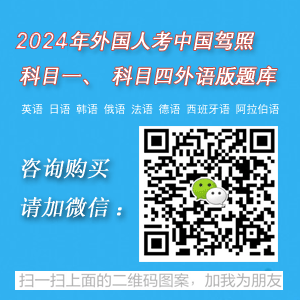2025妤犵偟绻濋懙鎴﹀炊娴犲鏁嬮柣鎾楀棌鍋撻崘顓犳Ц闁兼槒绮鹃銏㈢矓閹寸姵绐楀☉鎾亾闁靛棔鑳堕~鏍儎椤斿吋纾藉Λ鐗埫花閬嶅嫉婵夋墬F闁绘鐗炵槐婵嬪础閺夊灝鐓曞☉鏃撻檮濠€浼存晬鐏炴儳顤侀柡鍫f婢фPP闁挎稑鐗婂﹢渚€宕戝棰濇毌缂備礁鍟╃弧鍕晬鐏炵伕渚€骞忛悢鐑╁亾閸愵厾妲搁柛鏃傚枙閸忔﹢鏁嶆径娑氱闁告嚎鍔忛妤呭箣閺嶎剙鏋犲☉鏃€濯介顒勫礉閻樿京鐟撻梻鍫涘灮濞堟垵顕ラ璁崇箚闁挎冻鎷�

PDF闁绘鐗婇崺鍛村炊閹惧懐绐�

濞戞棑闄勫﹢浼村箣椤忓嫭绂堥柨娑虫嫹

闁归潧顑嗗┃鈧珹PP闁规惌浜滃ù姗€鏁嶉敓锟�

1. What will be subject to if submitting false materials to apply for driving license?
A. a 20~200 yuan fine
B. disqualification for applying for
C. cannot re-apply for within 1 year
D. cannot re-apply for within 2 years
Answer:C
2. May not drive if _____
A. the window is not closed
B. the door is not closed
C. the audio device is not closed
D. the roof window is not closed
Answer:B
3. Whats the meaning of this sign?

A. turn right
B. one-way road
C. going straight only
D. straight-going lane
Answer:A
4. A person who has falsified or altered the motorized vehicle driving license and if his act constitutes a crime, he should be held for criminal liabilities according to law.
A. Right
B. Wrong
Answer:A
5. What is the max speed on muddy road?
A. 15km/hr
B. 20km/hr
C. 40km/hr
D. 30km/hr
Answer:D
6. When driving at night, the driver should go at a lower speed because his field of vision is limited and he can hardly observe the traffic conditions beyond the area covered by his vehicle light.
A. Right
B. Wrong
Answer:A
7. When a vehicle approaches a crosswalk, the driver should ________.
A. Speed up and pass
B. Stop immediately
C. Honk to indicate the pedestrians to yield
D. Observe the movement of pedestrians and non-motorized vehicles, make sure it is safe before passing
Answer:D
8. The vehicles should run by the right shoulder of an expressway.
A. Right
B. Wrong
Answer:B
9. A person who has taken the state-controlled psychiatric substances can drive motorized vehicle in short distance.
A. Right
B. Wrong
Answer:B
10. How far away should the warning sign be placed in the coming direction when this vehicle breaks down and stops temporarily on the expressway?

A. beyond 150m
B. 50~150m
C. within 50m
D. 50~100m
Answer:A
11. How to pass when encountering this situation at the intersection?

A. make sure it is safe to pass
B. turn right and speed up to pass
C. speed up and pass straight
D. turn left and speed up to pass
Answer:A
12. Traffic markings are divided into indication, warning and prohibition.
A. Right
B. Wrong
Answer:A
13. A driver should buckled up before the vehicle moves.
A. Right
B. Wrong
Answer:A
14. What does this sign mean?

A. Reminding the side of a reservoir, lake or river ahead
B. Reminding the steep uphill road ahead
C. Reminding continuous two or more up slopes ahead
D. Reminding the steep downhill road ahead
Answer:B
15. If the driver finds there is no vehicle following, he can change lanes without turning on the turn signal.
A. Right
B. Wrong
Answer:B
16. This sign indicates indoor car park here.

A. Right
B. Wrong
Answer:B
17. Traffic Police can detain the vehicle according to law if it is suspected of using the label of insurance from other vehicle.
A. Right
B. Wrong
Answer:A
18. When driving at night, the driver should reduce speed and go forward if the vehicle coming in the opposite direction fails to turn off the high beam light. This is designed to prevent an accident from happening when there are pedestrians crossing the place where the lights of the two vehicles meet.
A. Right
B. Wrong
Answer:A
19. An unregistered motorized vehicle should have _________ if it has to run on the road temporarily.
A. certificate of legal origin
B. license plate for temporary moving
C. borrowed license plate
D. certificate of legal unit
Answer:B
20. Which part of the driver can be protected by the safety pillow when there is a rear-end collision?
A. waist
B. chest
C. head
D. neck
Answer:D
21. Do not start up a vehicle when the door or compartment is not properly closed.
A. Right
B. Wrong
Answer:A
22. It lights to indicate that ______

A. left-turn signal flashes
B. front and rear width lights light on
C. front and rear width lights light on
D. right-turn signal flashes
Answer:A
23. When reaching an intersection, the driver should _____ if a turning vehicle cuts in.
A. Stop to evade
B. Maintain the normal speed
C. Speed up and pass ahead of it
D. Honk and pass ahead of it
Answer:A
24. When driving at night, the drivers visibility range becomes shorter and his observation becomes poorer. At the same time, the driver can easily become tired because he has to highly concentrate his attention.
A. Right
B. Wrong
Answer:A
25. You can drive directly into the expressway from this position.

A. Right
B. Wrong
Answer:B




